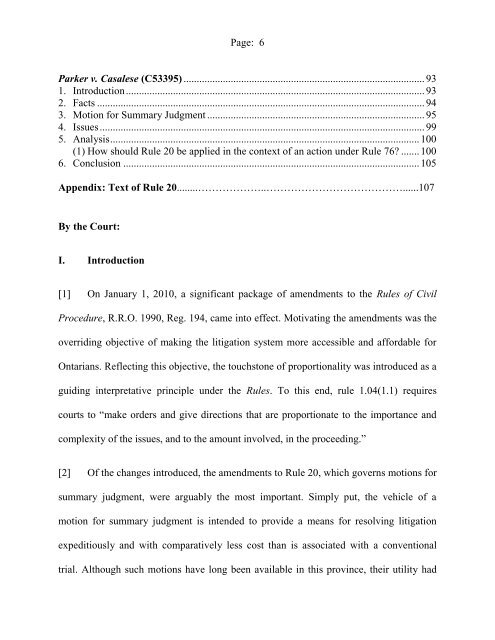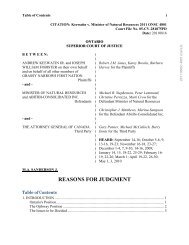COURT OF APPEAL FOR ONTARIO
COURT OF APPEAL FOR ONTARIO
COURT OF APPEAL FOR ONTARIO
Create successful ePaper yourself
Turn your PDF publications into a flip-book with our unique Google optimized e-Paper software.
Page: 6<br />
Parker v. Casalese (C53395) ............................................................................................ 93<br />
1. Introduction .................................................................................................................. 93<br />
2. Facts ............................................................................................................................. 94<br />
3. Motion for Summary Judgment ................................................................................... 95<br />
4. Issues ............................................................................................................................ 99<br />
5. Analysis ...................................................................................................................... 100<br />
(1) How should Rule 20 be applied in the context of an action under Rule 76? ....... 100<br />
6. Conclusion ................................................................................................................. 105<br />
Appendix: Text of Rule 20........………………..…………………………………......107<br />
By the Court:<br />
I. Introduction<br />
[1] On January 1, 2010, a significant package of amendments to the Rules of Civil<br />
Procedure, R.R.O. 1990, Reg. 194, came into effect. Motivating the amendments was the<br />
overriding objective of making the litigation system more accessible and affordable for<br />
Ontarians. Reflecting this objective, the touchstone of proportionality was introduced as a<br />
guiding interpretative principle under the Rules. To this end, rule 1.04(1.1) requires<br />
courts to “make orders and give directions that are proportionate to the importance and<br />
complexity of the issues, and to the amount involved, in the proceeding.”<br />
[2] Of the changes introduced, the amendments to Rule 20, which governs motions for<br />
summary judgment, were arguably the most important. Simply put, the vehicle of a<br />
motion for summary judgment is intended to provide a means for resolving litigation<br />
expeditiously and with comparatively less cost than is associated with a conventional<br />
trial. Although such motions have long been available in this province, their utility had
















